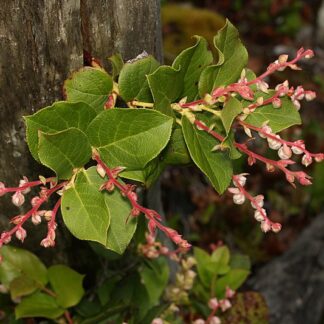Description
Sold in bundles of 10.
At a Glance: Multi-stemmed upright shrub with ridged young stems and arching older stems with peeling bark. White flowers.
Height: Up to 13 feet (4 meters).
Stems: Several main stems; young stems are rigged, older stems are brownish with peeling bark.
Leaves: Alternating arrangement; leaves are dull green and hairy, broadly egg-shaped, lobed or coarsely toothed; leaves can have reddish hue in autumn; size: 3-6 cm (1-2.5 in) long.
Flowers: Flowers are in dense terminal pyramidal cluster, 10-17 cm long; 5 white petals, 20 stamens, mostly 5 pistils, ovary is two-ovuled; flower clusters turn brown and remain on plants over winter; primary color: white to cream; size: 5 mm across.
Flowering Period: May, June.
Fruits: Hairy achenes; size: 2 mm long; color: light brown.
Ethnobotany: The wood of oceanspray is hard and durable. It was used to make digging sticks, spears, harpoon shafts, bows, and arrows by nearly all coastal groups including the Salish, Halqemeylem, Squamish, Sechelt, and Kwakwakawakw. The Saanich and Cowichan used the wood to make salmon-barbecuing sticks, inner bark scrapers, halibut hooks, cattail mat needles, and more recently knitting needles. Oceanspray pegs were used in construction before the use of nails. The Nlakapamux made armor plating from the hard oceanspray wood. The Squaxin used the wood to make canoe paddles.
The Saanich and Stlatlimx boiled the fruiting clusters of the oceanspray to make an infusion that was drank to cure diarrhea, measles, chickenpox. This infusion was also used as a blood tonic. The Lummi applied the leaves to sore lips and feet.
| Sun/Shade Tolerance | Hydrology | Elevation Range |
| Prefers open, sunny habitats.
full sun > 80%
mostly sunny 60%-80%
partial sun and shade 40%- 60%
mostly shady 60%-80%
full shade > 80%
|
Common in dry and moist habitats.
wet
moist
dry
|
low elevation
mid elevation
sub-alpine
high elevation
|
| Soil Preferences | ||
| Prefers well-drained rocky soils. | ||
|
sandy soils
gravelly soils
clay soils
muddy soils
peaty soils
|
well drained soils
shallow soils
deep soils
acidic soils
basic soils
|
humic soils
nutrient rich soils
nutrient poor soils
mineral soils
organic soils
|
| Wildlife Value | |
|
Berries
Seeds
Nectar for hummingbirds
Nectar for butterflies
Host for insect larvae
Thickets and shelter
Thorny or protective cover
|
Birds: During winter months, insect-eating birds such as chickadees and bushtits forage for insects in the shrub. The seeds persist through the winter. Dense branches provide songbirds with shelter and cover. Insects: Swallowtail, brown elfin, Lorquins admiral, and spring azure butterflies browse on the foliage. The nectar may be harvested by mature swallowtail butterflies. Many species of insects live in the dense structure of oceanspray. Mammals: Deer and elk browse the foliage. |






